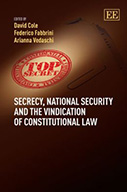Secrecy, National Security and the Vindication of Constitutional Law

Editors: David Cole, Federico Fabbrini, and Arianna Vedaschi
Publisher: Cheltenham, Gloucestershire, UK; Northampton, MA: Edward Elgar Publishing Limited, 2013.
358 p.
Reviewer: John T. Parry | May 2014
What do governments know about people (whether their citizens or others), how do governments use that information, and does anyone have a right to control, prevent, or even know about its collection and use? These questions have been at the forefront of constitutional concern for decades, and they have sharpened with each step in the advancement of telecommunications, computer, and internet technology. Even more, the combination of globalization and post-September 11, 2001 anti-terror efforts have fueled concerns about the extent to which contemporary liberal democracies are developing into secretive national security states. Most recently, of course, the disclosure of classified information by Wikileaks and Edward Snowden has confirmed the vast amount of data collected and used by the United States government, as well as its efforts to resist disclosure of information that has been designated in some way as useful for national security purposes.
Several writers (for example, Jeremy Waldron in his 2010 collection, Torture, Terror, and Trade-Offs) have made important contributions to political and constitutional theory debates about the “balance” between liberty and security. Many other writers have addressed doctrinal developments in their own jurisdictions. But the need for a comparative perspective on the detailed questions that have arisen about the collection, maintenance, and use of information by governments – and the impact of these practices on constitutional structure and constitutional rights – has been growing ever more urgent.
Secrecy, National Security and the Vindication of Constitutional Law goes a long way toward meeting that need. The introduction and 18 chapters in this collection focus on the U.S., Europe, and Commonwealth countries, with some discussion of Israel and other countries, and they provide deeply researched and thoughtful perspectives on the specific legal issues relating to government secrecy in the national security context. Further research on more countries outside North America and Western Europe is badly needed as well. But, the focus of this book highlights the extensive cooperation among American and European governments with respect to the collection, sharing, and use of information to forward common or overlapping national security objectives.
Each contributor to Secrecy, National Security and the Vindication of Constitutional Law takes as a given that constitutional doctrine – whether the national constitutional law of a particular country or the developing constitutional law of the European Union – requires serious skepticism about claims that information must be collected and used in secret because of national security concerns. None of the authors doubt that governments must keep secrets; nor do they insist that governments must provide complete transparency with respect to all of their actions. Clearly, however, these authors reflect and take concrete steps to analyze and redress a sense that contemporary government secrecy practices threaten to outstrip constitutional control. The result is essential reading for anyone who studies, litigates, or otherwise has an interest in these issues.
The contributions to Secrecy, National Security and the Vindication of Constitutional Law are divided into five parts: secrecy and courts, secrecy and legislatures, secrecy and detention, secrecy and criminal trials, and secrecy and administrative measures. Although there is inevitably some overlap among the sections, this organization highlights and advances the book’s focus on the ways in which national security secrecy strains separation of powers values and increases the vulnerability of the people who are detained or subjected to legal proceedings in the name of national security concerns.
The secrecy and courts section begins with a short chapter by Lord Justice Stephen Sedley, which traces some of the critical developments in U.K. secrecy law – developments in which Lord Sedley often participated. Next, Stephen Schulhofer and Mindia Vashakmadze consider, in their respective chapters, the interaction between national courts and executive officials in the United States and Germany. But, demonstrating the value of overlap, Schulhofer also argues that Congress should shake off its deficiencies and do more to control the process of declassification, to protect whistleblowers, and to strengthen its oversight of the executive branch. As for the courts, he demonstrates that they have more expertise in secrecy issues than the judges themselves might realize, and he calls for them to use this expertise to buttress rule of law values by “provid[ing] objective, narrowly tailored reconciliation of the competing values – security and transparency – on which the survival of a healthy democracy depends” (43). Sudha Setty’s valuable chapter on the ways in which courts move back and forth between formalism and pragmatism in their assessment of secrecy issues closes out this section.
In the section on secrecy and legislatures, the chapter by Kathleen Clark and Nino Lomjaria dovetails with Schulhofer’s chapter by providing a detailed study of congressional oversight in the United States and parliamentary oversight in Canada. In their account, the direct and indirect access that members of Congress have to secret information puts them in a far better position than their counterparts in Canada, who are much more at the mercy of the executive branch. Clark and Lomjaria do not extol the U.S. system, but they do emphasize the multiple practical ways in which information becomes available to legislative overseers. From there, of course, one must ask whether this degree of access and potential for oversight also entails greater complicity in the larger structure of secrecy. The section concludes with Arianna Vedaschi’s compelling account of state secrets in Italian law – an account which calls for the Constitutional Court to play a more searching role in overseeing government invocations of the state secrets privilege.
The chapters in the section on secrecy and detention continue to address a separation of powers theme – the access of one branch to secret information held by another – but do so in a charged context: the use of secret evidence to justify the detention or other restriction of a person suspected of engaged in terrorist activity. The section begins with Kent Roach’s survey on “Managing Secrecy and Its Migration in a Post-9/11 World.” The word “managing” reveals Roach’s emphasis on ongoing engagement with the problems created by secrecy, and his corresponding concern about efforts to “solve” the problem through one-time interventions or to use procedural structures created in one context as a template for other solutions. The remaining chapters in the section come from Shiri Krebs, on preventive detention in Israel, from Andrew Lynch, Tamara Tulich and Rebecca Welsh, on control orders in the United Kingdom and Australia, and from David Cole and Stephen Vladeck, on secret evidence and cleared counsel in a variety of U.S., U.K. and Canadian proceedings.
The methodology of the Cole-Vladeck chapter exemplifies the goals of this collection. They describe the practices of the U.S., U.K., and Canada and note the overlaps and differences among them. Next, they address what they see as the basic constitutional issue with respect to secret evidence: the ability to provide procedural fairness to litigants when national security and secrecy become an issue. Critically, they argue “not merely that each of these three countries could learn from each other when it comes to striking the right balance between secrecy and fairness in national security litigation, but that, because of the constitutional traditions, they must incorporate these lessons” (175). To assist that learning process, they develop a set of “best practices” for managing – and revealing – secret information in a way that supports basic fairness and reliability. They close by suggesting that no amount of process can overcome the “fatal flaw” of the prior decision to compromise “the right of an individual to confront the evidence against him when the government seeks to deprive him of liberty” (192).
The Cole-Vladeck chapter also sets up the three chapters in the next section, all of which explore the various ways in which secrecy can affect the conduct of criminal trials in ways that include but go beyond the use of classified information. Jason Mazzone and Tobias Fischer offer an intriguing and sophisticated account of anonymous testimony that suggests the development of real procedures, rather than ad hoc accommodations, when anonymous testimony is warranted. Clive Walker also explores the tension between norm and exception in his assessment of trials of suspected terrorists. He argues for the primacy of a criminal justice model, rather than a national security model, but more fundamentally he stresses the “willingness to engage in reflection and reform” in order to produce structures that will “affirm legitimacy” (228). Ori Aronson continues the theme of this section by examining through a Foucauldian lens the ways in which military tribunals in the United States and Israel valorize a distinction between “spaces that societies establish in order to distinguish among the ‘normal’ elements of moral and political life (civilian adjudication) and those which are their essential others (military tribunals)” (229).
The final section of Secrecy, National Security and the Vindication of Constitutional Law contains four chapters on administrative measures against suspected terrorists. In all of the chapters, by Tuomas Ojanen, Cian Murphy, Federico Fabbrini, and Deirdre Curtin, the focus is less on the law of a particular country and more on the ways in which European institutions have struggled to accommodate secrecy and national security interests – including the partnership with the U.S. – with fairness to litigants (although Ojanen also provides a wonderful account of how Finnish courts have struggled with these issues in immigration proceedings). For readers who know relatively little about the European approach to these issues, this last section provides a wealth of information and trenchant analysis. Each chapter stands alone as a meaningful contribution; taken together, the whole nonetheless manages to exceed the sum of its parts.
Lech Garlicki’s concluding remarks return to a more general level by surveying the themes of the book from the perspective of a judge (retired) on the European Court of Human Rights. His discussion of the court’s work helps draw the various themes into a set of conclusions – that constitutional courts and lawyers have tools to address national security and secrecy issues, that these efforts must be mindful of the pressures created by real threats to national security, and that “constitutional aspects of secrecy” are not a matter of law alone but must also be “analyzed within the more general context of politics and economy” (337). Certainly, the analysis in Secrecy, National Security and the Vindication of Constitutional Law, legal and otherwise, provides tools for superior – perhaps even optimal – approaches to national security and secrecy issues.
John T. Parry, Jeffrey Bain Faculty Scholar and Professor of Law, Lewis & Clark Law School


